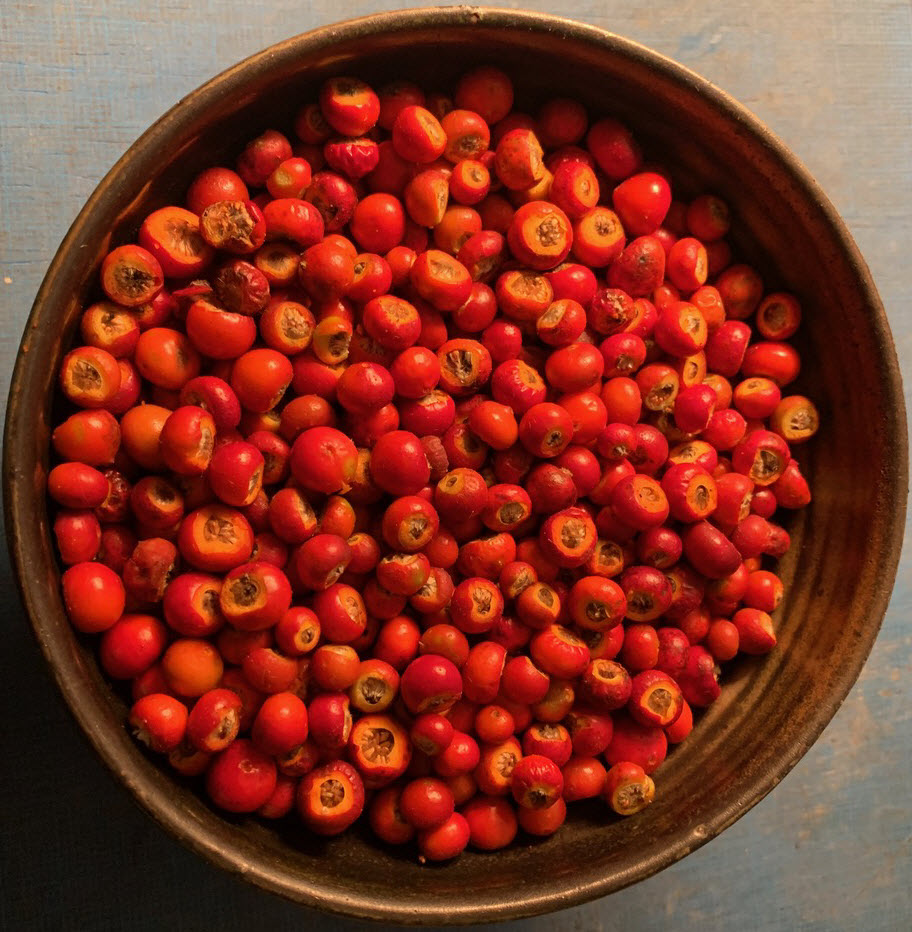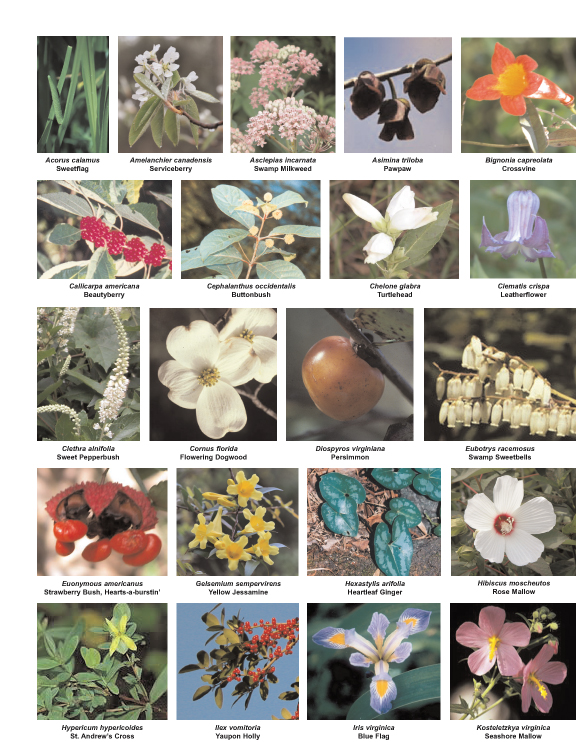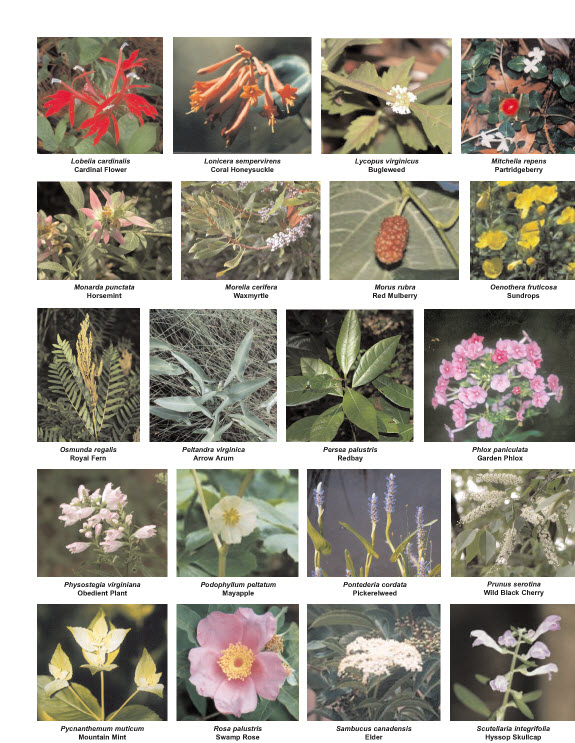a bit About Our Plants
Wild Woods Farm Native Nursery
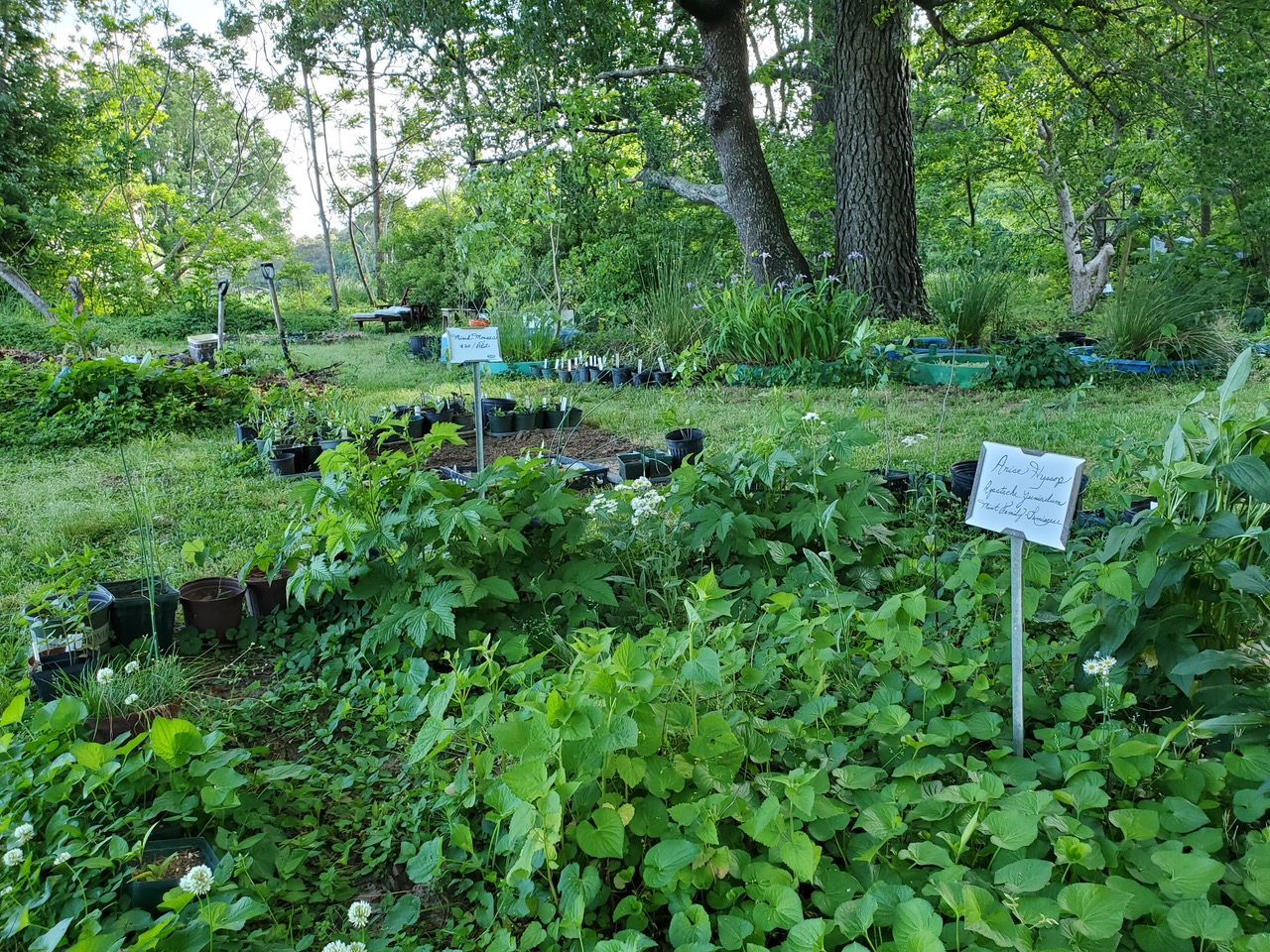
The Wild Woods Farm is a 16-acre native nursery located in northeastern North Carolina where native and medicinal plants are grown in their natural habitat. The inventory fluctuates, so call or email for additional information. To schedule a visit, call Vickie at (757) 406-0061 or email wildfood@cox.net.
Please browse through our growing list of plants!
Native Plant Sale
The Virginia Native Plant Society will be hosting a plant sale at Wild Woods Farm in the southern section of Virginia Beach on Saturday, October 7 from 10-2:00. A portion of the proceeds will benefit the Native Plant Society. For more information email wildfood@cox.net.
Forest Botanicals
Dried Herbs
Yaupon Holly
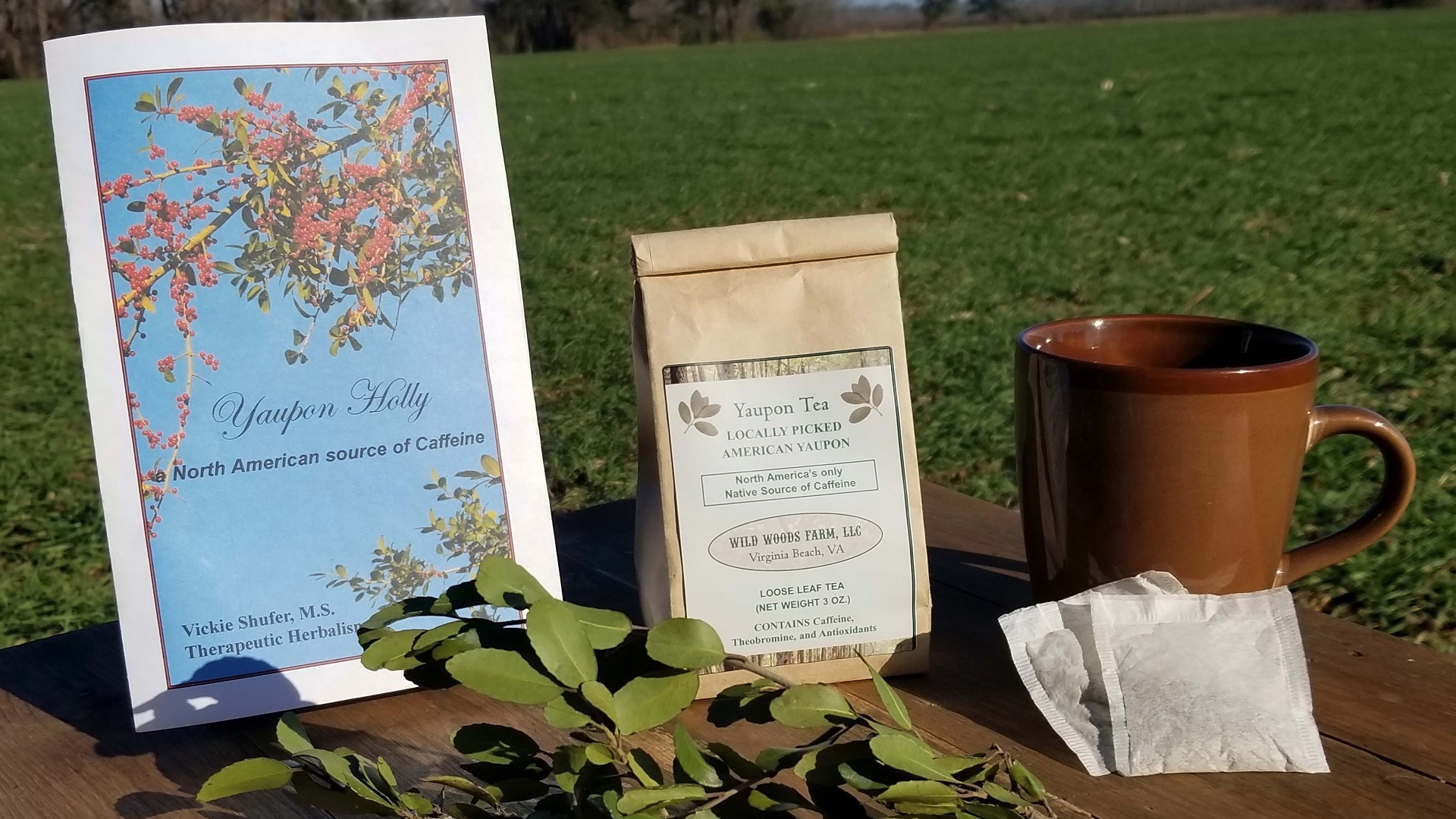
Yaupon Holly is a member of the holly family with evergreen
leaves and waxy, red berries that ripen just in time for the
December holiday season. The leaves are sustainably
harvested, dried, and roasted to make a stimulating tea that
contains caffeine, theobromine, and antioxidants.
Yaupon is available from Wild Woods Farm in loose leaf, dried and roasted, by the pound, in 3-oz. bags, or as sampler tea bags. It is also available by the pound unroasted.
• loose leaf, roasted and ground – $12/3 oz
• fresh picked, unroasted, air-dried – $30/lb
• sampler tea bags, roasted & ground – $2/ea
Click Here for More Information on Yaupon Holly
Click Here for Our Card on Yaupon Holly
Grow Your Own
Growing your own herbs for food and medicine is rewarding and satisfying. It allows for providing the nurturing and caring that are needed for the plant to thrive plus it helps you to connect with the plant as you watch it grow through its cycle. Here at Wild Woods Farm we have a variety of plants to choose from. Here is a list of what’s available:
Native Plants
Beautyberry (Callicarpa americana)
Beebalm (Monarda didyma)
Black-eyed Susan (Rudbeckia hirta)
Blue Flag Iris (Iris virginica)
Elder (Sambucus canadensis)
Ginger, Wild (Hexastylis arifolia)
Grape, Muscadine (Vitis rotundifolia)
Horsemint (Monarda punctata)
Mallow, Rose (Hibiscus moscheutos)
Mountain Mint (Pycnanthemum muticum)
Phlox, Garden (Phlox paniculata)
Redbay (Persea palustris)
Sumac, Winged (Rhus copallinum)
Virginia Snakeroot (Endodeca serpentaria)
Waxmyrtle (Morella cerifera)
Yarrow (Achillea millefolium)
Culinary/Medicinal Plants
Feverfew
Garlic Chives
Grindelia
Holy Basil
Motherwort
Peppermint
Spearmint
Sweet Annie
Elderberry - Sambucus canadensis
Grow your own elderberry syrup - canes now available from Wild Woods Farm - $3/bare root.
Click Here for More Information on Elder
Virginia Native Plant Society Annual Sale
Hundreds of native plants available with knowledgeable volunteers to answer your questions
Lynnhaven House Historic Site
4409 Wishart Road, Virginia Beach
Saturday, April 2, 2022
9:00 a.m. - 3:00 p.m.
Native Plants for Southeast VA
p. 1; p. 2 Illustrated Plant List: p. 1 – A-E; • p. 2 – E-O; • p. 3 – O-Z
Mosses – now available!
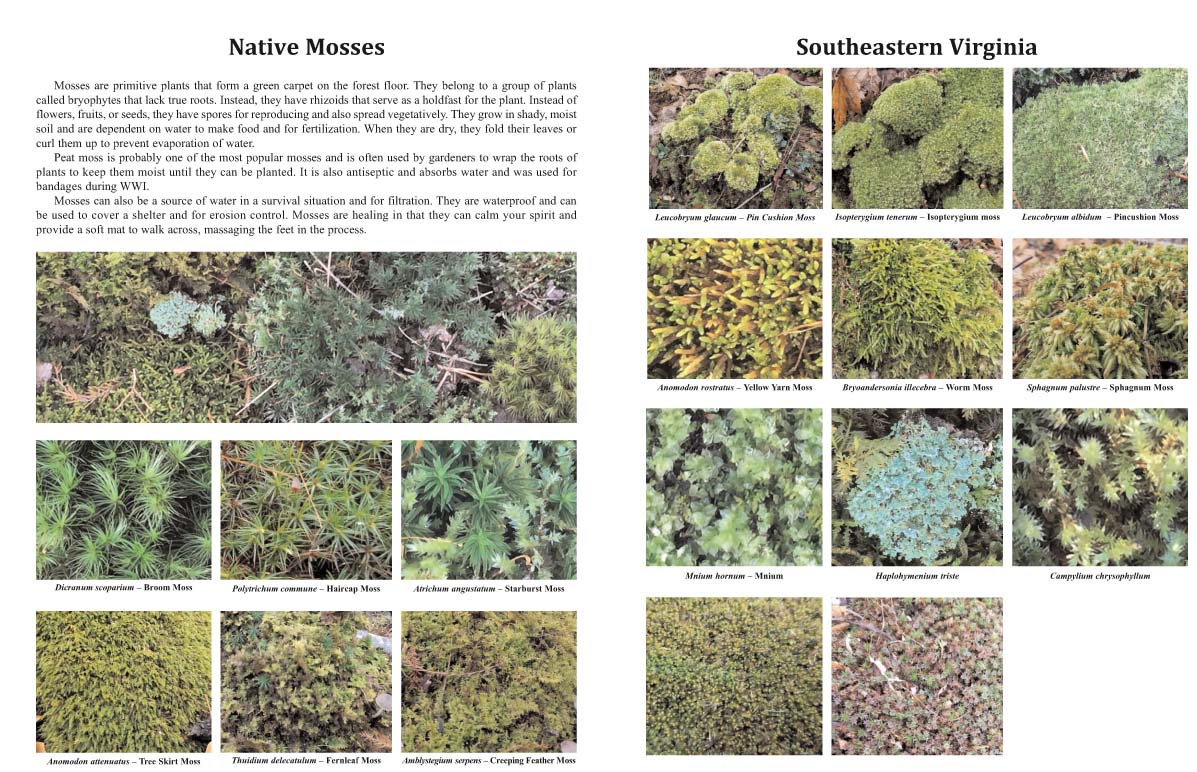
Mosses are primitive plants that form a green carpet on the forest floor. They belong to a group of plants called bryophytes that lack true roots. Instead, they have rhizoids that serve as a holdfast for the plant. Instead of flowers, fruits, or seeds, they have spores for reproducing and also spread vegetatively. They grow in shady, moist soil and are dependent on water to make food and for fertilization. When they are dry, they fold their leaves or curl them up to prevent evaporation of water.
Peat moss is probably one of the most popular mosses and is often used by gardeners to wrap the roots of plants to keep them moist until they can be planted. It is also antiseptic and absorbs water and was used for bandages during WWI.
Mosses can also be a source of water in a survival situation and for filtration. They are waterproof and can be used to cover a shelter and for erosion control. Mosses are healing in that they can calm your spirit and provide a soft mat to walk across, massaging the feet in the process.
• Achillea millefolium (Asteraceae) – Yarrow
Description & Habitat: Yarrow is a perennial wildflower that grows in open, sunny areas as well as part shade along the edges of fields and forests. It blooms in the summer with flat-topped clusters of small, white flowers. Leaves have a fern-like appearance and emit a fragrance when crushed.
• Acorus calamus (Araceae) – Sweetflag
Description & Habitat: A wetland emergent plant that grows 2-3 feet tall in freshwater marshes with long, stiff, sword-like light green leaves. Tiny, greenish-yellow flowers develop on a spadix that resembles the leaves. All parts of the plant have a sweet aromatic taste and scent.
• Amelanchier canadensis (Rosaceae) – Serviceberry
Description & Habitat: Serviceberry is a small tree or shrub that grows in the understory of hardwood forests. White flowers emerge early in the spring before the leaves have developed followed by purplish berries that ripen in May.
• Arisaema triphyllum (Araceae) – Jack-in-the-pulpit
Description & Habitat: Jack-in-the-pulpit is a perennial herb that grows in moist woods. It has compound leaves that are divided into 3 leaflets at the top of a long stem, usually in pairs and about 1-2 feet tall. The flower is a spathe with a curved hood that is green or purplish-brown, sometimes marked with pale or whitish stripes. Fruits are a cluster of bright, red berries that ripen in late summer and fall.
• Aronia arbutifolia (Rosaceae) – Red Chokeberry
Description & Habitat: A small shrub that grows in wet, boggy areas and is frequently seen on small islands in cypress swamps. It has small white, fragrant flowers in flat-topped clusters with 5 petals that bloom in the early spring, followed by bright red berries that ripen in the fall. Leaves have finely toothed margins.
• Asclepias incarnata (Asclepiadaceae) – Swamp Milkweed
Description & Habitat: A perennial summer wildflower that grows in full sun or part shade at the edges of swamps, bays and canals. It has pink flowers with 5 recurved petals, followed by an elongated pod filled with flat seeds attached to a downy parachute.
• Asclepias tuberosa (Asclepiadaceae) – Butterflyweed
Description & Habitat: Butterflyweed grows in fields, roadsides and dry, open areas. Small, bright orange flowers with 5 down-curved petals form a cluster at the stem’s end. Narrow leaves alternate on the stem.
• Asimina triloba (Annonaceae) - Pawpaw
Description & Habitat: Pawpaws form patches in the understory of the forest with long, oval-shaped leaves that emit a pungent odor when bruised. Maroon-colored flowers appear in the spring before the leaves have developed followed by green colored fruits that resemble a short banana. The fruits turn yellow as they ripen in late summer.
• Asplenium platyneuron (Aspleniadaceae) – Ebony Spleenwort
Description & Habitat: An evergreen fern of moist woodlands with a smooth, glossy red-brown stem and alternate pinnae. Fertile fronds stand erect above the shorter, spreading, sterile fronds.
• Aster dumosus (Asteraceae) – Bushy Aster
Description & Habitat: A bushy-looking plant with stiff, leafy branches that produce numerous white or pale lavender flowers in the late summer.
• Athyrium asplenioides (Polypodiaceae) – Lady Fern
Description & Habitat: A deciduous fern that is lacy-looking in appearance and may reach up to 2 feet tall. Fronds are long and tapering, being broadest in the middle.
• Baccharis halimifolia (Asteraceae) – Saltbush, Groundsel Bush
Description & Habitat: A bushy shrub that grows in salt marshes that is covered with an abundance of greenish-white flowers in late summer followed by silky bristle-like fruits. Male and female flowers on separate plants.
• Bignonia carpeolata (Bignoniaceae) – Crossvine
Description & Habitat: A high-climbing vine that grows in moist woods and swamps. It is evergreen where the winters are mild. Heart-shaped leaves are paired with 2 leaflets and a branched tendril between them. Orange red flowers are trumpet-shaped with a yellow center and grow in axillary clusters on the stem.
• Callicarpa americana (Verbenaceae) – Beautyberry
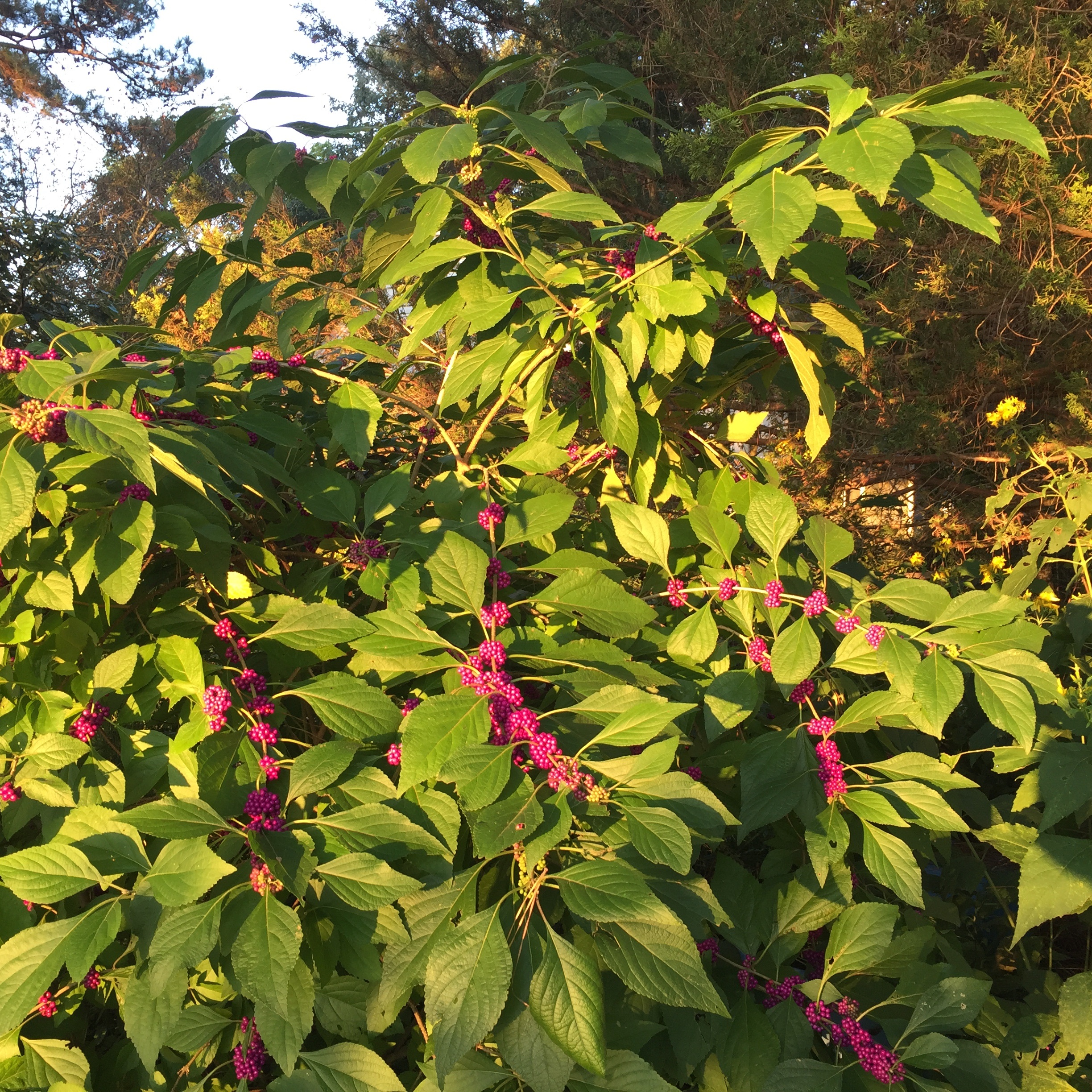
Description & Habitat: Beautyberry is a small shrub that grows in woodland openings or along the edges of southern forests. Clusters of small pink flowers develop on the stem in late spring or early summer, followed by berries that turn bright purple in the fall.
Click Here for More Information on Beautyberry
• Cardamine diphylla (Brassicaceae) – Toothwort
Description & Habitat: A perennial wildflower that grows in moist woodlands during the winter months, blooms in early spring with 4 white petals, and then dies back during the summer months.
• Cephalanthus occidentalis (Rubiaceae) – Buttonbush
Description & Habitat: A medium-sized shrub that grows along the borders of streams and lakes. White balls of tiny fragrant flowers appear in late spring through summer. The fruit is a rough, brown ball with many seeds that mature in autumn.
• Chelone glabra (Scrophulariaceae) – Turtlehead
Description & Habitat: A wetland plant that grows 2-3 feet tall in freshwater swamps, along streams and other wet areas. The leaves are opposite, lance-shaped and sharply toothed. White flowers develop in late summer and slightly resemble the head of a turtle – hence the name.
• Clematis crispa (Ranunculaceae) – Leatherflower
Description & Habitat: A perennial vine that grows at the edges of wet areas, it has leaves that are divided into 3-9 oval-shaped leaflets. Bell-shaped fragrant flowers are bluish-purple with wavy-edged sepals and hang from a slender stalk.
• Clethra alnifolia (Clethraceae) – Sweet Pepperbush
Description & Habitat: Sweet pepperbush is a deciduous shrub that grows in the understory of wet or swampy forests. Leaves are alternate, sharply pointed and doubly toothed on the margin. Clusters of white, fragrant flowers develop on stalks that are 2 to 6 inches long in mid-summer. Fruits are rounded capsules that resemble peppercorns and mature in the fall, often remaining on the plant through the winter.
• Cornus florida (Cornaceae) – Flowering Dogwood
Description & Habitat: A small, deciduous tree that grows in the understory of hardwood forests in both moist and dry soils. It has elliptical-shaped leaves that are opposite and yellowish-green flowers surrounded by four showy, white, petal-like bracts. The fruit is a berry that turns shiny red when mature.
• Crataegus phaenopyrum (Rosaceae) – Washington Hawthorn
Description & Habitat: A small, deciduous, understory tree with thorny stems that grows in moist soils. Leaves are sharply toothed and 3-lobed. It blooms in late spring with flowers that have 5 white petals followed by a fruit that looks like a miniature apple that turns shiny red when it ripens in the fall.
• Decumaria Barbara (Hydrangeaceae) – Climbing Hydrangea
Description & Habitat: A semi-evergreen vine that grows in moist woods and swamps. Aerial roots give it a hairy appearance, not to be confused with poison ivy. Leaves are opposite, somewhat rounded at the base and toothed above the middle. Small, white fragrant flowers form clusters at the ends of branchlets from April to June.
• Dioscorea villosa (Dioscoreaceae) – Wild Yam
Description & Habitat: A perennial vine that grows in damp woods with heart-shaped leaves; bottom leaves in whorls of 3-8. Small greenish-yellow flowers are inconspicuous and hang in drooping racemes.
• Diospyros virginiana (Ebonaceae) – Persimmon
Description & Habitat: Persimmon is a small to medium-sized tree that grows at the edges of forests, on sand dunes and hillsides from Connecticut south to Florida and west to eastern Texas. The oval-shaped leaves are from 3-6 inches long with smooth margins. Trees are either male or female – both are needed to get fruits which is a round berry, about 1-2 inches in diameter and turns orange when ripe, sometimes mottled with purple.
• Elephantopus carolinianus (Asteraceae) – Elephant’s Foot
Description & Habitat: A woodland herb that grows in mostly shade with oval-shaped leaves and a flower stalk that is topped with 3 leafy bracts containing white to pale purple ray-like flowers.
• Endodeca serpentaria (Aristolochiaceae) – Virginia Snakeroot
Description & Habitat: A perennial herb woodland herb with wavy stems that grows 6-18 inches tall. The leaves have a heart-shaped base and a pointed tip. Flowers are dull brown or purplish and develop near the base of the plant from May to July.
• Erigeron pulchellus (Asteraceae) – Robin’s Plantain
Description & Habitat: A perennial wildflower that grows along the edges of fields and wooded areas with partial sunlight. It has a basal rosette of leaves with a flower stalk that is 1-2 feet tall, topped with 2-6 whitish-lavender rays of flowers.
• Eubotrys racemosus (Ericaceae) – Swamp Sweetbells
Description & Habitat: A deciduous shrub that grows in moist woodlands near swamps and along streams. One-sided racemes with white, fragrant, bell-shaped flowers hang from the stems. Leaves are lance-shaped with finely toothed margins. Fruits are dry capsules that are round and somewhat flattened.
• Euonymous americanus (Celastraceae) – Strawberry Bush, Hearts-a-burstin’
Description & Habitat: A small shrub with green stems and paired oval-shaped leaves that grows in rich woods and along stream banks. Small, greenish flowers in late spring often go undetected. The fruits, however, are quite showy and mature in the fall, becoming bright red and dangling from a warty pod.
• Euthamia graminifolia (Asteraceae) – Grass-leaved Goldenrod
Description & Habitat: A perennial wildflower that grows in open, sunny areas. Long, narrow grass-like leaves alternate on the stem topped with flat-topped clusters of yellow flowers that bloom in late summer.
• Eutrochium dubium (Asteraceae) – Joe-pye-weed
Description & Habitat: A perennial wildflower that reaches 2-5 feet tall with whorls of 3-4 lance-shaped leaves on a slender stem topped with a cluster of whitish-pinkish flowers. It grows at the edges of streams and waterways in partial sunlight.
• Gaylussacia frondosa (Ericaceae) – Dangleberry
Description & Habitat: A low-growing shrub in sandy woods and bogs with oval shaped leaves, pale green above, paler and resin-dotted beneath. Small bell-shaped flowers are greenish-white or pinkish followed by a bluish berry.
• Gelsemium sempervirens (Gelsemiaceae) – Yellow Jessamine
Description & Habitat: Yellow jessamine is an evergreen, woody vine that climbs over trees, shrubs and other structures. It is an early bloomer, producing yellow, tubular-shaped flowers in late March or early April with a mild, sweetish scent.
• Hexastylis arifolia (Aristolochiaceae) – Ginger, Evergreen
Description & Habitat: An evergreen plant that grows on the forest floor of mature hardwood forests. Leaves are heart-shaped, leathery in texture, and somewhat mottled on the surface. Maroon colored flowers about an inch long develop in early spring under the leaves. The flowers resemble “little brown jugs”, another name for the plant.
• Hibiscus moscheutos (Malvaceae) – Rose Mallow
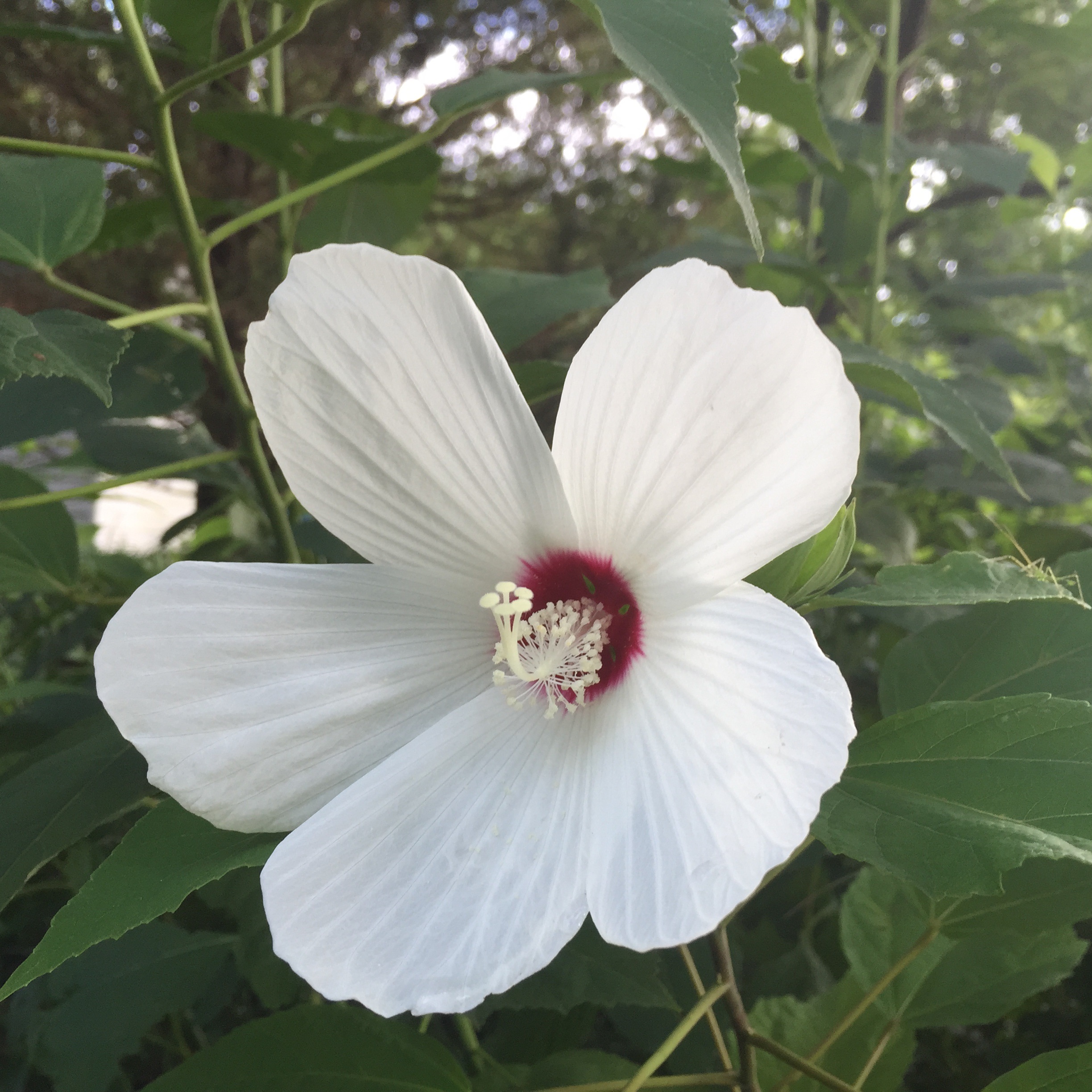
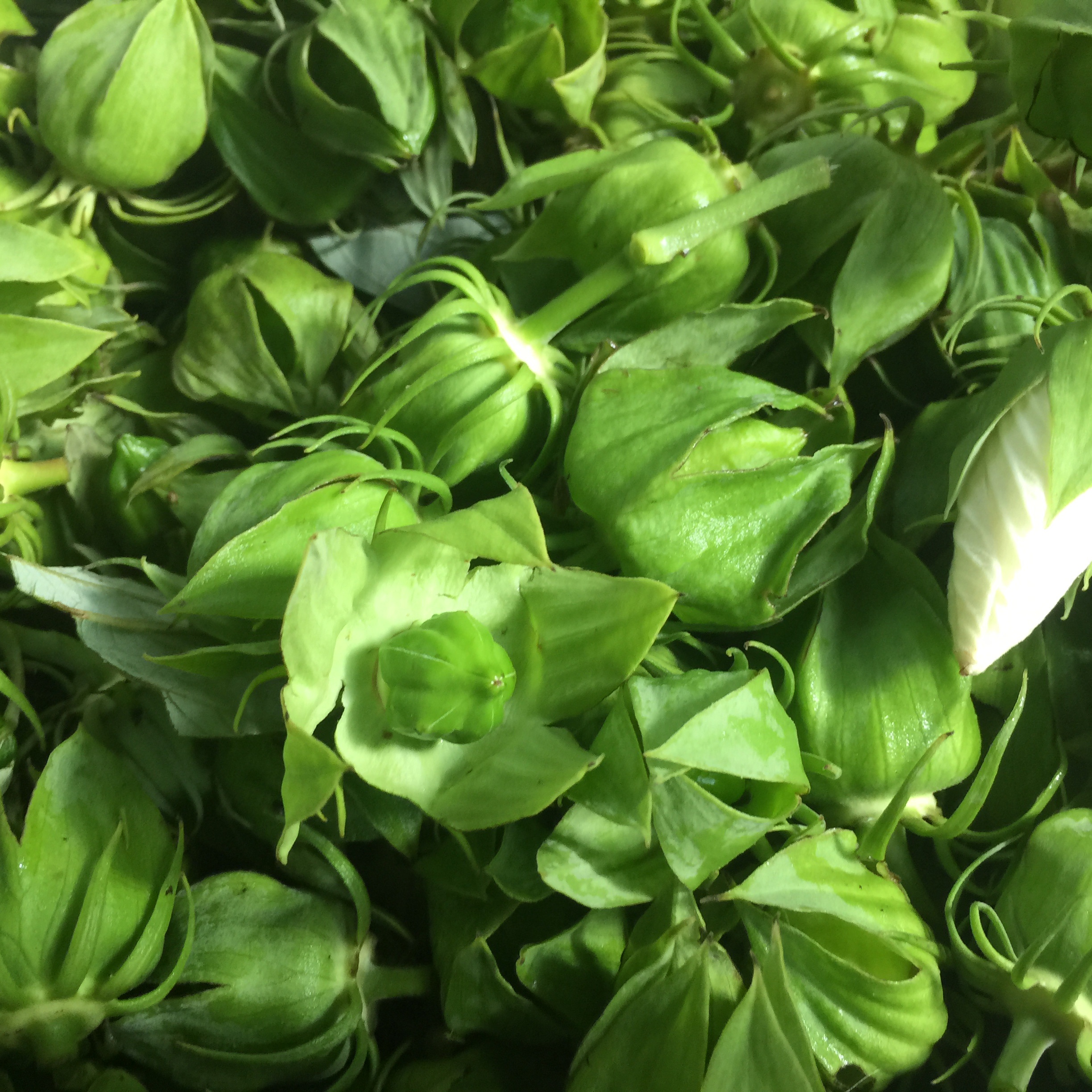
Description & Habitat: Rose mallow is a tall perennial plant that grows in tidal and freshwater marshes. It produces arge white flowers that have red or purple centers in mid-summer. Leaves are about 4 inches long, toothed and somewhat lobed.
Click Here for More Information on Mallow
• Hieracium venosum (Asteraceae) – Rattlesnake Weed
Description & Habitat: Rattlesnake weed is a woodland herb that is easily recognized by its basal leaves, which are green with reddish-purple veins. In late spring and into the summer, it sends up a flower stalk that produces a loose cluster of bright yellow flowers less than one inch across.
• Hydrocotyle umbellata (Apiaceae) – Pennywort
Description & Habitat: Pennywort is a wetland plant that creeps along the edges of streams, bays and rivers. It is easily recognized by the round leaf that has a leaf stem coming out of the center. Leafless flower stalks arise from the stem with an umbel of small white flowers.
• Hypericum hypericoides (Hypericaceae) – St. Andrew’s Cross
Description & Habitat: A woody shrub up to a foot tall with lemon yellow flowers that have 4 petals and blooms in mid to late summer. Leaves are small and grow in pairs. The seed is a pod enclosed by a pair of large sepals.
• Hypericum punctatum (Hypericaceae) – St. Johnswort
Description & Habitat: A short-lived perennial wildflower found in damp woods, thickets and fields. Leaves are small with rounded tips and small, black dots on their surface. Flower stalks from 1 to 3 feet tall develop in late spring and early summer and produce clusters of small, yellow flowers with 5 petals, also with black dots.
• Ilex opaca (Aquifoliaceae) – American Holly
Description & Habitat: An evergreen, understory tree in mixed hardwood forests. Leaves are thick and leathery with sharp, spiny tips on the margins. The fruit is a bright red berry that matures in the fall and remains on the plant through the winter.
• Ilex vomitoria (Aquifoliaceae) – Yaupon Holly
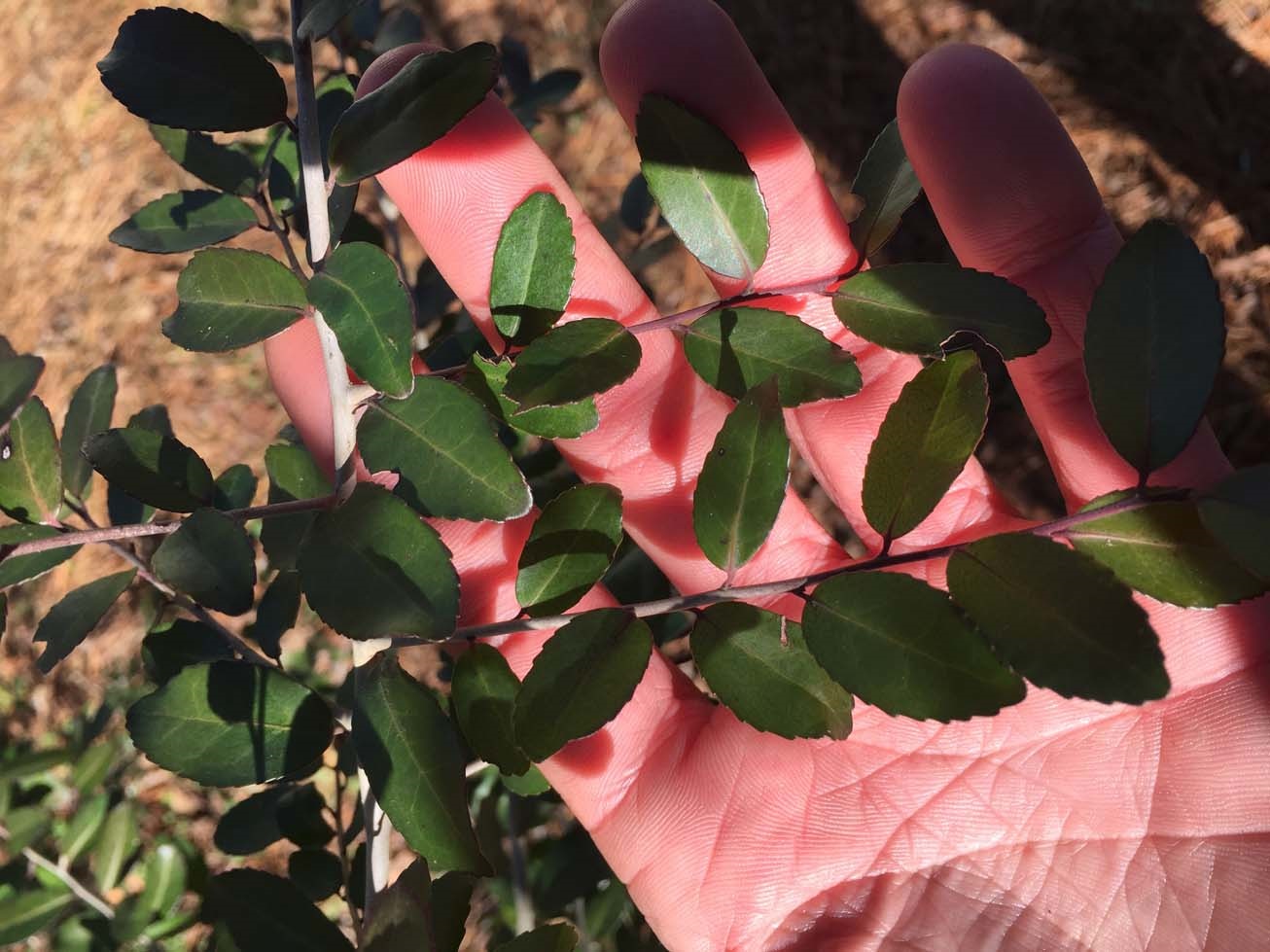
Description& Habitat: Yaupon is a broadleaf evergreen shrub or small tree that grows in the understory of the forest or along the edges. It has small, glossy green leaves and bright red berries that ripen during the winter, making it a favorite for Christmas decorations.
Click here if you're interested in purchasing Yaupon Holly!
• Iris virginica (Iridaceae) – Blue Flag Iris
Description & Habitat: An emergent, wetland plant that grows along the edges of freshwater marshes. It blooms in the spring with large violet-blue flowers. Pale green leaves are long and sword-like.
• Itea virginica (Iteaceae) – Sweetspire
Description & Habitat: A deciduous shrub that grows in swamps and wetland areas in partial sun with drooping racemes of white, fragrant flowers in early summer
• Juncus effusus (Juncaceae) – Soft Rush
Description & Habitat: An emergent wetland plant with round stems that have soft tips and a branched inflorescence that appears to emerge from the side of the stem.
• Juncus roemarianus (Juncaceae) – Black Needlerush
Description & Habitat: Black needlerush forms thick colonies along the edges of brackish and saltwater marshes. The dark colored leaves, tipped with a sharp, needle-like point, give the plant its name.
• Kosteletzkya virginica (Malvaceae) – Seashore Mallow
Description & Habitat: Seashore Mallow is a 3-4 feet perennial herb that grows in brackish or tidal freshwater marshes. Terminal pink flowers develop in late summer followed by a flat greenish fruit with 1-seeded segments.
• Leucothoe axillaris (Ericaceae) – Dog-hobble
Description & Habitat: An evergreen shrub with dark green leathery leaves that grows in wet woods and swamps in the coastal region. White, bell-shaped flowers hang in the axils of the leaves in early spring. The fruit is a dry capsule.
• Lobelia cardinalis (Campanulaceae) – Cardinal Flower
Description & Habitat: Cardinal flower is easily recognized in mid-summer by its brilliant red, tubular flowers borne at the top of an erect stalk that arises from a basal rosette of toothed leaves. It can be found in moist soil and along the edges of freshwater streams and rivers.
• Lonicera sempervirens (Caprifoliaceae) – Coral Honeysuckle
Description & Habitat: A climbing vine at the edges of forests and thickets, coral honeysuckle can be distinguished from Japanese honeysuckle by its bright red tubular flowers that appear in the spring. Leaves are opposite with smooth margins, with the upper leaves joined together around the stem.
• Lycopus virginicus (Lamiaceae) – Bugleweed
Description & Habitat: Also known as wood betony, bugleweed is a perennial herb that grows in moist, shady soils and wetlands. Tiny white flowers form dense clusters in whirls around a square stem where the leaves join the stem in late summer and early autumn. Leaves are opposite, often purple-tinged and sharply toothed.
• Lyonia ligustrina (Ericaceae) – Maleberry
Description & Habitat: A deciduous, medium-sized shrub that grows in the shade of moist to dry forests with alternate, finely-toothed leaves. It blooms in the spring with small, white, globe-shaped flowers. The fruit is a small, somewhat rounded capsule.
• Magnolia virginiana (Magnoliaceae) – Sweetbay Magnolia
Description & Habitat: Sweetbay magnolia is an understory tree that grows in wet soils and along borders of swamps and streams. Large, leathery, oval-shaped leaves are shiny green above and whitish underneath. They persist on the trees where winters are mild. The large, white fragrant flowers are more than 2 inches across and bloom in late spring and early summer.
• Mitchella repens (Rubiaceae) – Partridgeberry
Description & Habitat: A perennial evergreen that sprawls on the forest floor with roundish leaves that are in pairs and have white veins. Tubular flowers are in pairs, with the fruit developing at the base where the two join, leaving two blossom scars on the berry and turning red when mature in late autumn.
• Monarda didyma (Lamiaceae) – Bee balm
Description & Habitat: A member of the mint family, it has paired leaves and a square stem topped with a head-like cluster of bright red, tubular flowers during the summer months. It grows in moist woods and along streams.
• Monarda punctata (Lamiaceae) – Horsemint
Description & Habitat: An aromatic, perennial wildflower that grows in dry, sandy soils. It blooms during the summer months with pale yellow flowers, spotted with purple in whorled tiers on the square stem.
• Morella cerifera (Myricaceae) – Waxmyrtle
Description & Habitat: Waxmyrtle is a coastal evergreen shrub or small tree with yellow-green aromatic leaves and bluish-gray waxy berries that ripen in the fall.
• Morus rubra (Moraceae) – Mulberry, Red
Description & Habitat: Medium-size tree with large, ovate leaves that have a long-pointed tip and three main veins arising from the base. The surface is rough above with soft hairs beneath. Tiny flowers are crowded in narrow clusters that become the berry that is made up of many 1-seeded fruits, turning red to dark purple when ripe.
• Oenothera fruticosa (Onagraceae) – Sundrops
Description & Habitat: Sundrops is a herbaceous perennial that grows in full or part sun in dry or moist soil. It has a rosette of leaves with a flower stalk that grows up to 3 feet tall and blooms in the spring with bright yellow flowers that have 4 petals.
• Onoclea sensibilis (Onocleaceae) – Sensitive Fern
• Osmunda spectabilis (Osmundaceae) – Royal Fern
Description & Habitat: A deciduous fern that reaches several feet in height and grows in bogs and wet forests. Spores are on fertile leaflets at the end of the frond, turning brown after the spores are released.
• Peltandra virginica (Araceae) – Arrow Arum
Description: Arrow Arum is an emergent, aquatic plant that is found in freshwater swamps and marshes. The large leaves are heart-shaped with long stalks and prominent veins. The flower is a spathe that resembles a pointed rolled leaf and develops into a fruiting head of black or blackish-green berries.
• Persea palustris (Lauraceae) – Swamp Bay
Description & Habitat: A broad-leaved evergreen understory tree that grows at the edges of swamps and moist woodlands. Large, elliptical shaped leaves are thick and leathery and emit a fragrant scent when crushed. It has red, fuzzy buds on the twigs and stems. Small, yellowish-white flowers grow in small clusters in the leaf axils followed by a small, dark blue drupe that matures in the fall.
• Phegopteris hexagonoptera (Thelypteridaceae) – Broad Beech Fern
Description & Habitat: A shade-loving fern that grows in moist woodlands that has arching, triangular fronds that are once divided with the pinnae deeply cut. Spores are on the underside of the frond near the leaf margin.
• Phlox paniculata (Polemoniaceae) – Garden Phlox
Description & Habitat: A perennial wildflower that grows 2 to 4 feet tall in part to full sun with opposite, elliptical shaped leaves. The flowering period goes from July to September with pink to white, tubular flowers that are fragrant and grow in terminal clusters.
• Physostegia virginiana (Lamiaceae) – Obedient Plant
Description & Habitat: A perennial wildflower with paired, lance-shaped leaves that grows in part sun in thickets and edges of swamps. It sends up a 1-4 foot flower stalk in early summer with a spike-like cluster of pinkish flowers along the upper part of the square stem.
• Podophyllum peltatum (Berberidaceae) – Mayapple
Description: A woodland plant that comes up in the early spring and easily recognized by its large, umbrella-like leaves reaching up to about a foot in heigh on the forest floor. Solitary, white flowers about 2 inches wide develop in the fork of plants with paired leaves, followed by a greenish-yellow lemon-like fruit that ripens in early summer.
• Pontederia cordata (Pontederiaceae) – Pickerelweed
Description & Habitat: An emergent wetland with large heart-shaped leaves arising from the water in freshwater marshes and along the edges of streams and canals. Flower stalks are topped with a spike of bluish-purple flowers that give way to starchy seeds.
• Prunus serotina (Rosaceae) – Black Cherry
Description & Habitat: A small to large tree, black cherry grows in woods, thickets and hedgerows. Toothed leaves are long and narrow with pointed tips. In the spring, clusters of white, fragrant flowers develop on the ends of branches, followed by small, blackish fruits that ripen in the summer.
Download This Black Cherry Monograph (PDF)
• Pycnanthemum muticum (Lamiaceae) – Mountain Mint
• Rhus copallinum, R. glabra, R. typhina – Sumac
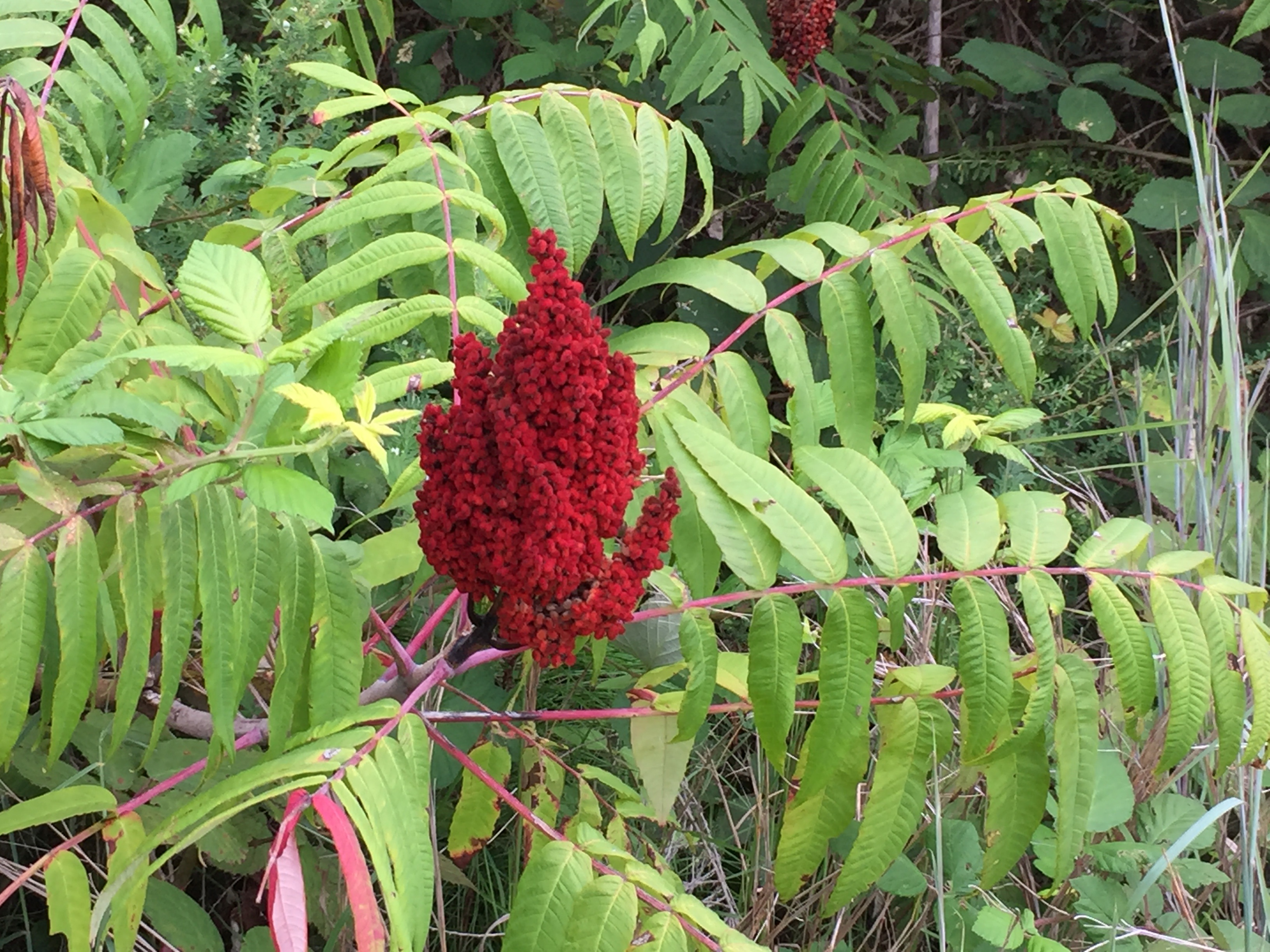
Description & Habitat: Sumac is a deciduous shrub that grows on the sides of roads, interstates, fields, anyplace where there is an opening of light or disturbed soil. It sends out horizontal underground stems that sprout and form colonies. Sumacs can be divided into two groups: poison sumac and non-poison sumac. The poison sumac (Toxidendron vernix) has white berries that hang in loose clusters while the non-poison sumac (Rhus spp.) has red, tightly clustered berries. The poison sumac, which fortunately is a lot less common than the others, can cause a contact dermatitis reaction, similar to poison ivy, in some people. Large, compound leaves that turn flaming red in the fall, are characteristic of both groups.
Click here if you're interested in purchasing Sumac Ade - Nature's lemonade!
• Rosa palustris (Rosaceae) – Swamp Rose
Description & Habitat: A branching shrub found in swamps and marshes, the swamp rose grows up to 7 feet tall and is armed with stout, hooked thorns. Leaves are compound with usually 5-7 toothed leaflets. It blooms in late spring with fragrant, pink flowers with five petals and yellow center stamens. The fruit is a hip and turns red when it ripens in late fall.
• Salix nigra (Black Willow)
Willow Family – Salicaceae
Black willow is a small tree that is valued as a buffer tree in wetland areas, stabilizing the banks and preventing shoreline erosion. The long, narrow leaves are finely saw-toothed and slightly curved to one side. There are male and female trees with drooping catkins on the male in early spring.
Click Here for More Information on Black Willow
• Sambucus canadensis (Adoxaceae) – Elder
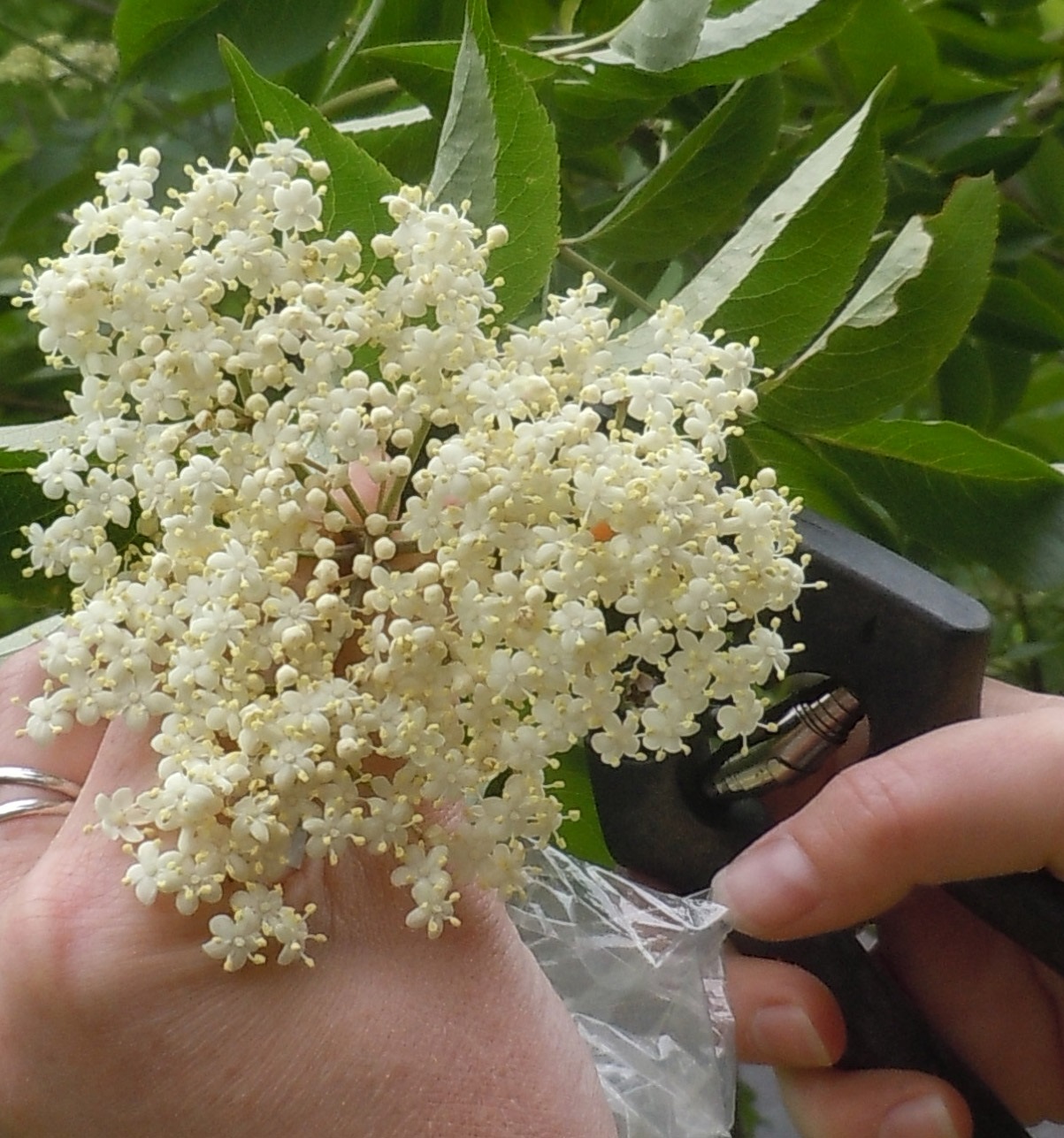
Description & Habitat: Elder is a deciduous shrub or small tree that grows at the edges of forests, fields, and in open areas near water, forming a large crown with its spreading branches. Flat-topped clusters of small, white flowers appear in late spring with 5 petals that are about one-fourth inch wide and mildly fragrant. Following the flowers are the purple-black berries, which ripen during the summer months. Leaves are pinnately compound with 3-7 toothed leaflets growing in pairs.
Click Here for More Information on Elder
• Scutellaria integrifolia (Lamiaceae) – Hyssop Skullcap
Description & Habitat: A perennial wildflower that grows in clearings and open woodlands, it has opposite leaves and bluish-lavender flowers about 1 inch long that bloom in the summer.
• Scutellaria lateriflora (Lamiaceae) – Mad-dog Skullcap
Description & Habitat: A perennial wildflower that grows in wet soils and at the edges of swamps. Small, bluish-purple flowers branch out on slender stalks in late summer.
• Symphyotrichum tenuifolium (Asteraceae) – Salt Marsh Aster
• Vaccinium formosum, V. fuscatum (Ericaceae) – Blueberry, Highbush
Description & Habitat: A deciduous shrub from 3-10 feet tall found in the understory of forests. Leaves are oval-shaped with smooth margins and a somewhat zig-zagged stem. White, bell-shaped flowers develop in the early spring followed by a blue berry, sometimes with a whitish bloom that ripens in late spring or early summer.
• Viburnum dentatum (Adoxaceae) – Arrowwood
Description& Habitat: A medium-sized shrub that grows along the edges of freshwater swamps and in the understory of the forest. In the spring it is covered with white flat-topped clusters of flowers. These are followed by small, blue-black fruits that ripen in late summer.
• Viburnum nudum (Adoxaceae) – Possum Haw
Description & Habitat: A shrub, sometimes small tree, that grows in moist soils near waterways or the edges of swamps. Leaves are opposite, 2-5 inches long, with smooth margins and turns bright red in the autumn. White, flat-topped clusters of flowers appear in the spring and are followed by a bluish-black drupe that ripens in the fall.
• Vitis rotundifolia (Vitaceae) – Muscadine Grape
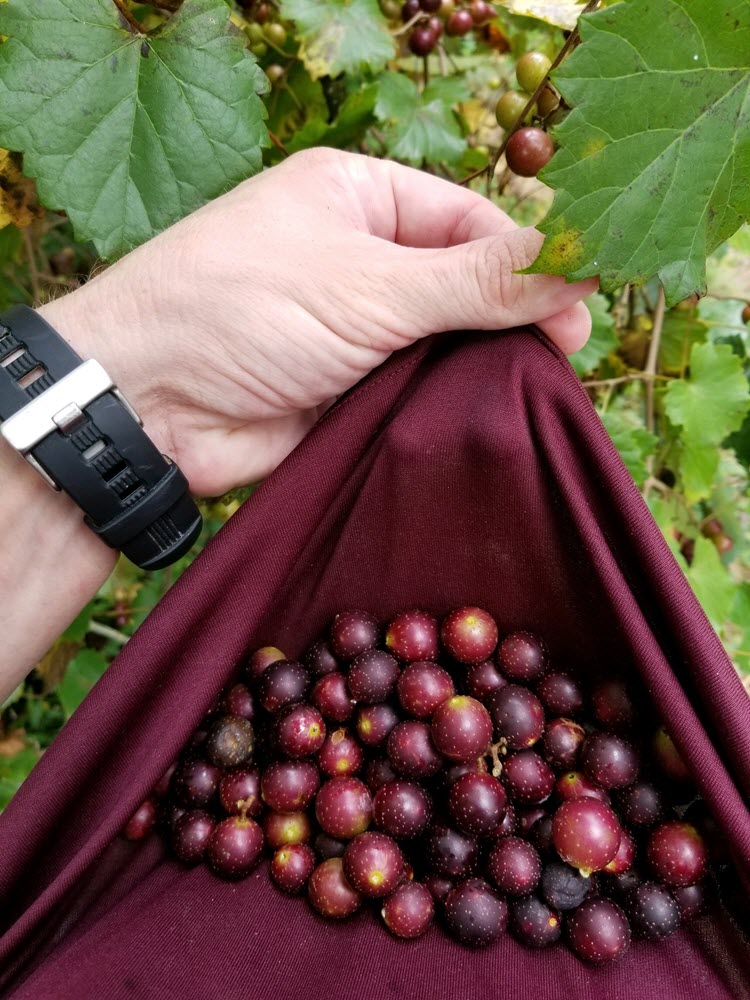
Muscadine grapes just beginning to ripen
Description & Habitat: A climbing, deciduous woody vine that grows in woods, thickets, sand dunes, and swamps. Leaves are heart-shaped and sharply toothed with a V-shaped sinus at the base. Yellowish-green flowers appear in late spring and are followed by a berry that is purplish-black and ripens in late summer and into the fall.
• Woodwardia areolata (Blechnaceae) – Netted Chain Fern
• Zanthoxylum clava-herculis (Prickly Ash)
Prickly ash is an aromatic, small tree with spreading branches and stout spines on the trunk. Also known as the toothache tree, the toothed projections on the trunk fits with the “Doctrine of Signatures” which states that herbs that have parts that resemble parts of the body can be used to treat those parts. In this case, the bark has a numbing effect on the gums and stimulates the salivary glands. The leaves are compound with 5-13 leaflets, often with paired spines at the base. When crushed they emit a citrus smell. Small, yellow-green flowers develop in branched clusters at the ends of twigs in the spring. Biting into the flower buds is similar to biting into the peel of an orange.
Click Here for More Information on Prickly Ash
• Zephyranthes atamasco (Liliaceae) – Atamasco Lily, Easter Lily
Description: Atamasco lily is a flowering herbaceous plant that grows from an underground bulb along the edges of wetland areas. It is sometimes called Easter Lily because it produces beautiful white flowers around easter time. The flower stalks are leafless, however, several flat and narrow leaves arise from the bulb around the flower stalk.
Turmeric Tubers - tubers used with prickly ash seed capsules to make Zest! seasoning
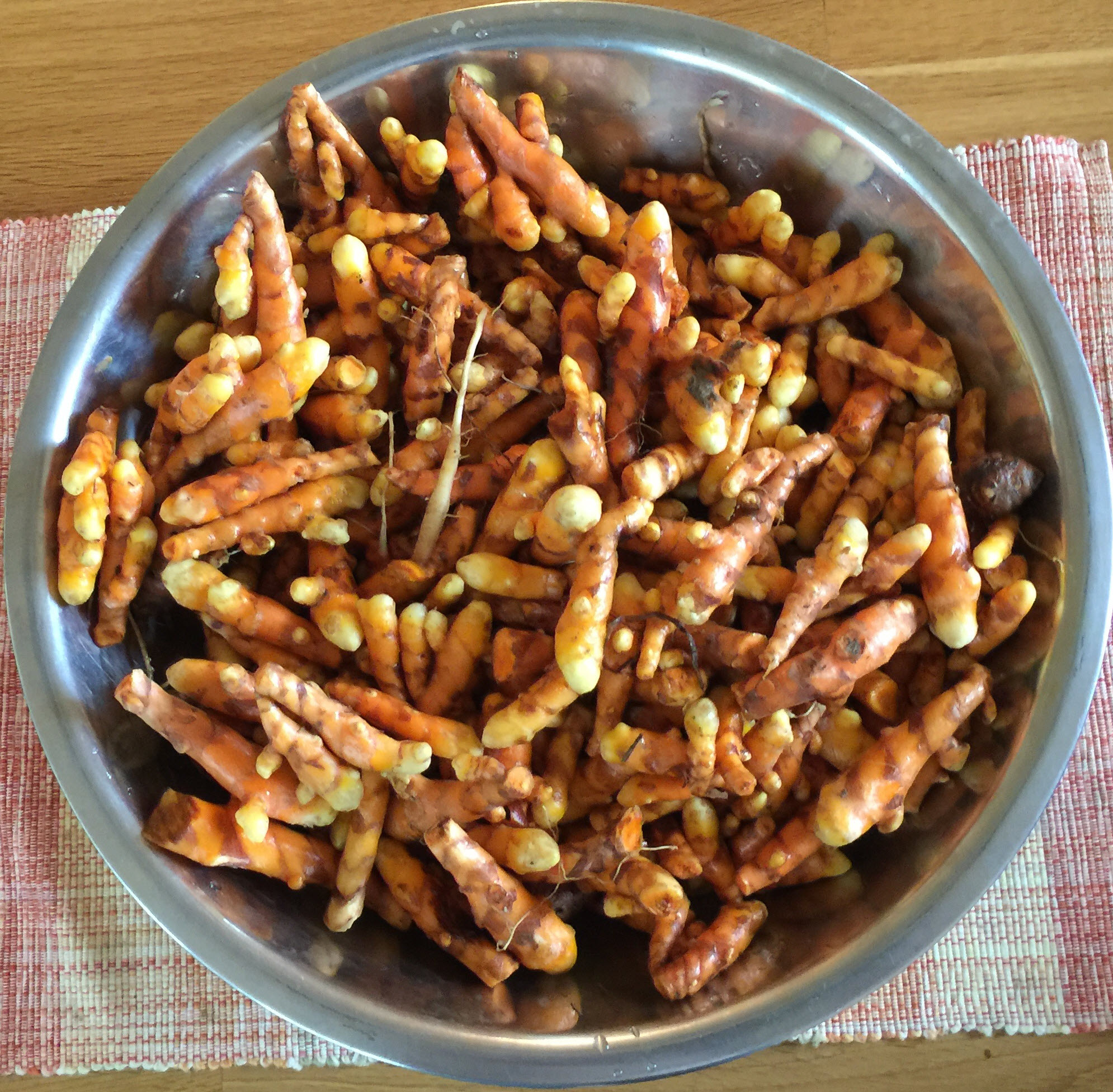
elder flower syrup in the making
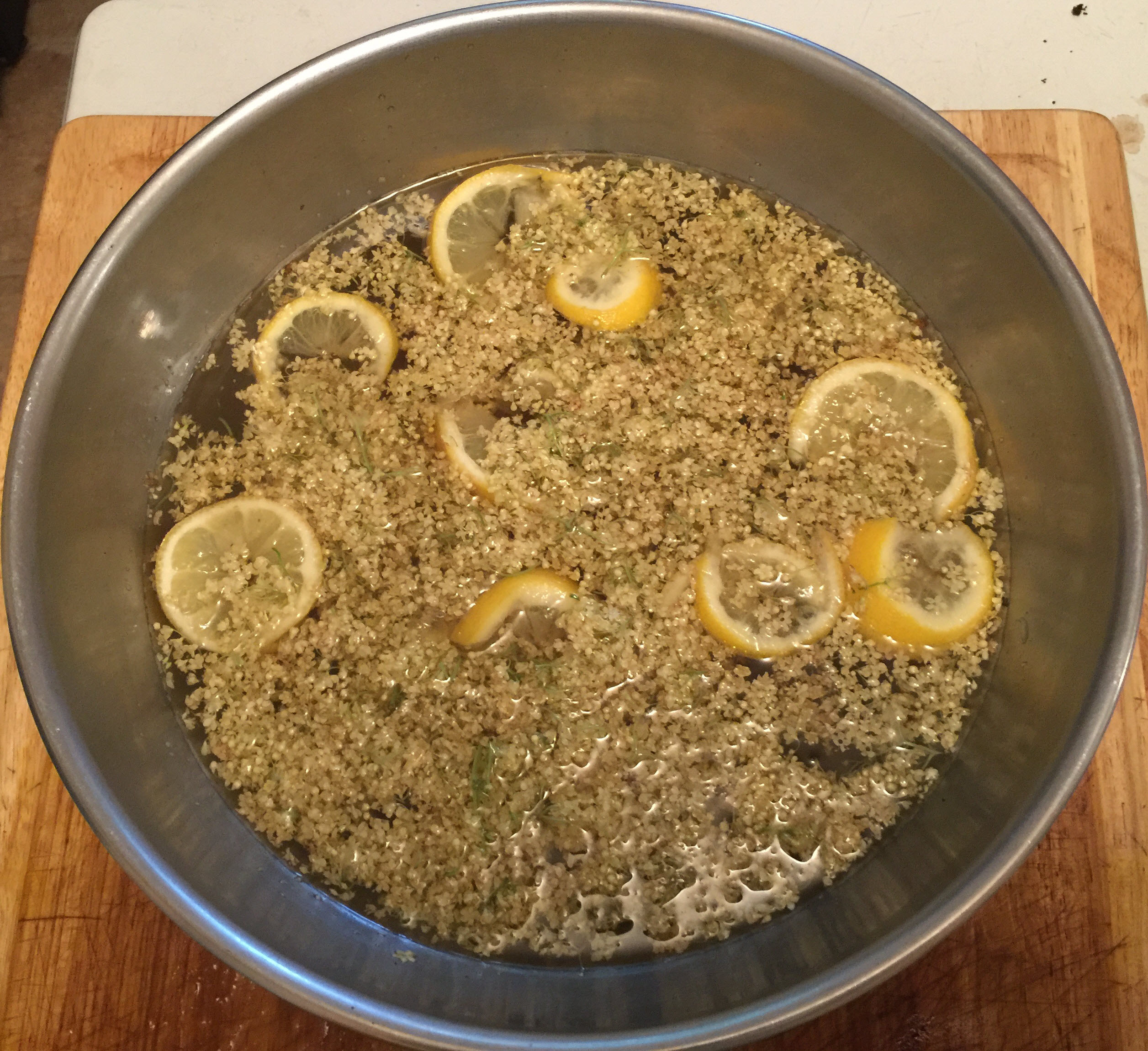
Vickie harvesting yaupon holly
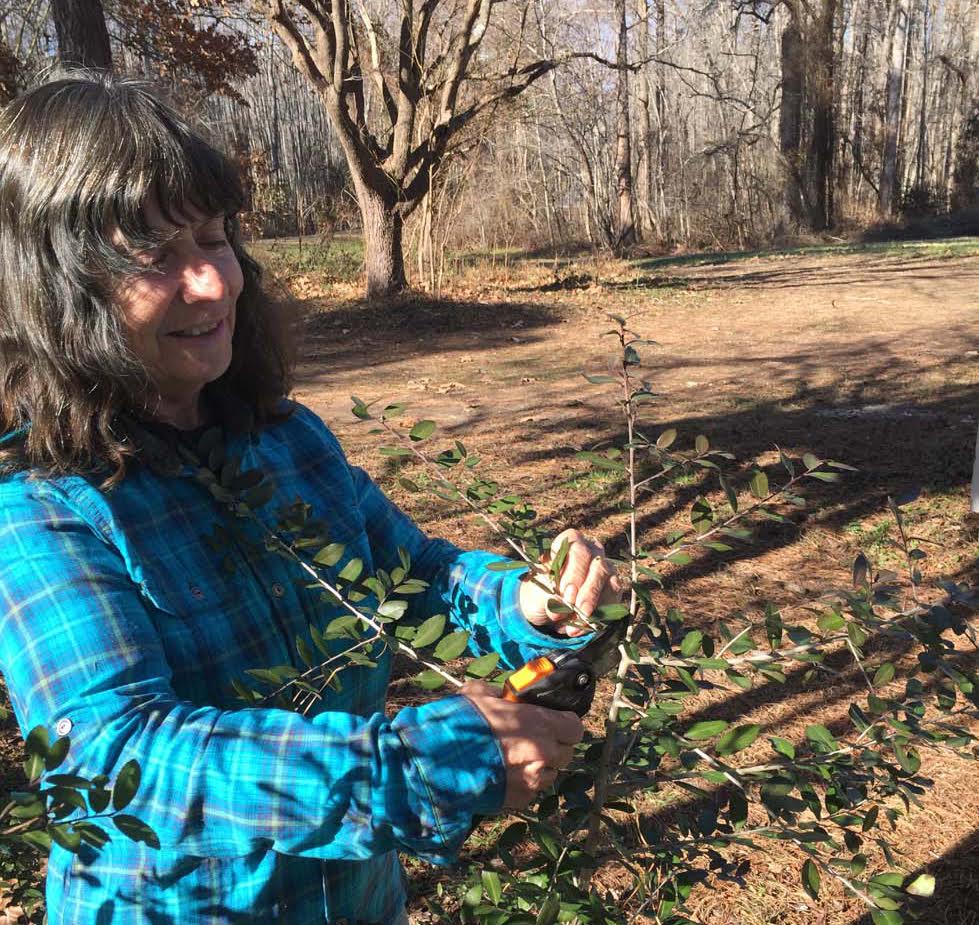
St. johnswort infused in oil
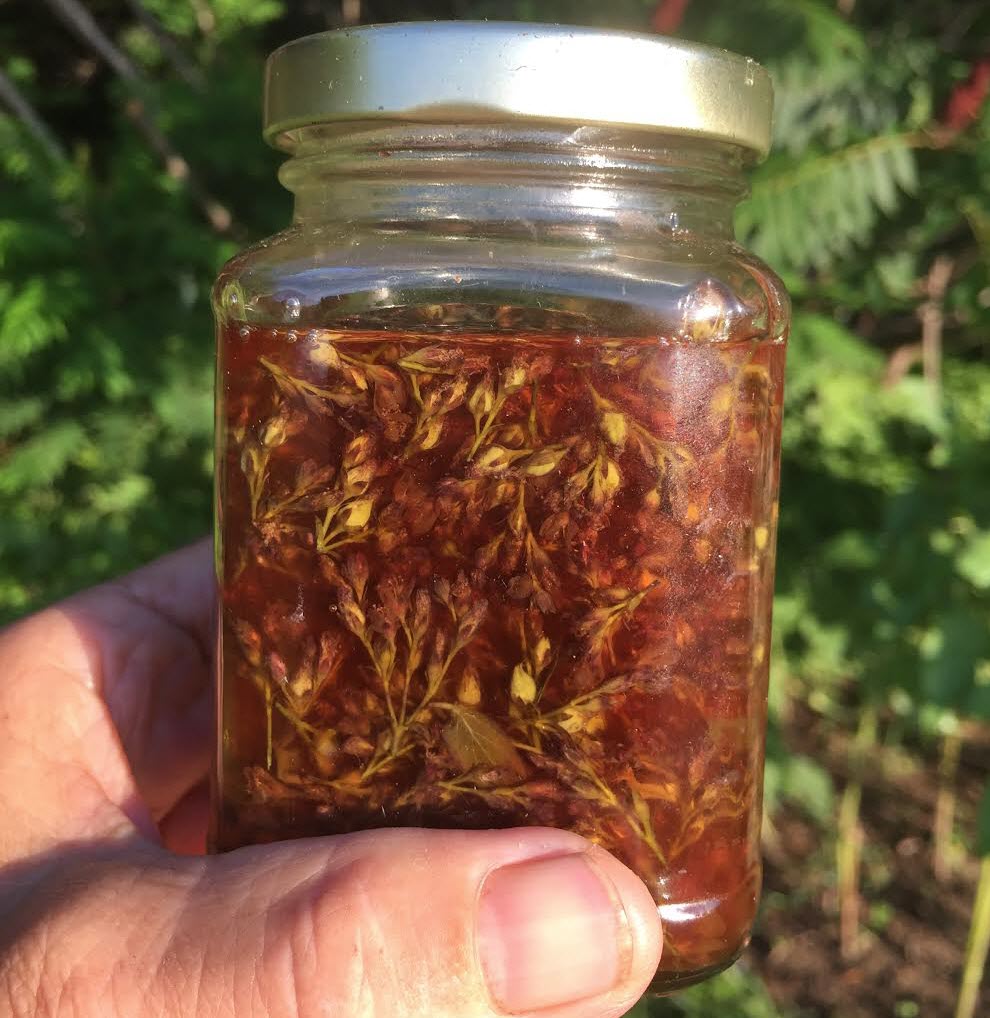
prickly ash leaves and seeds - Seed capsules used to make Zest! - an herbal seasoning that also includes turmeric and black pepper
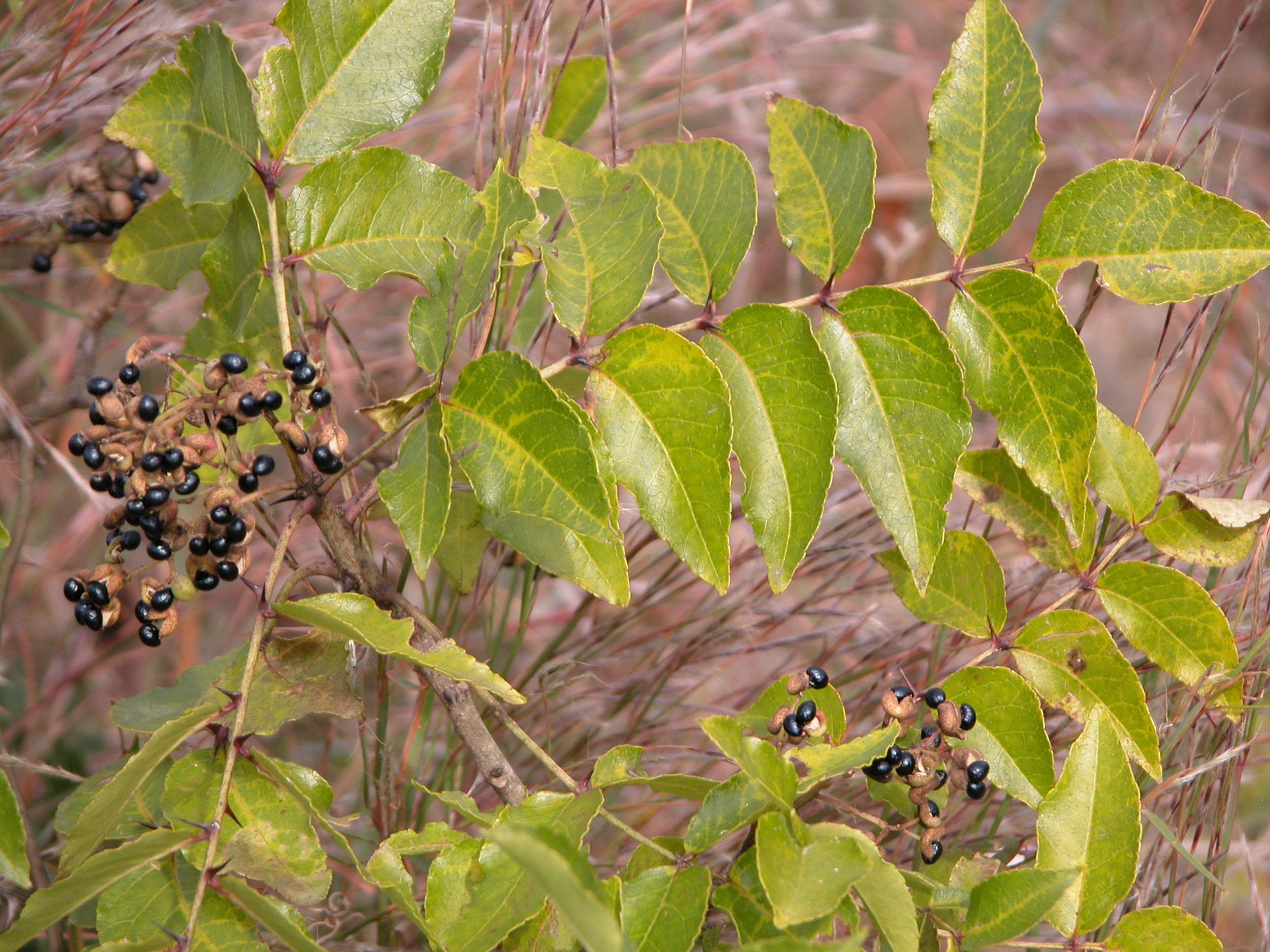
dwarf azalea
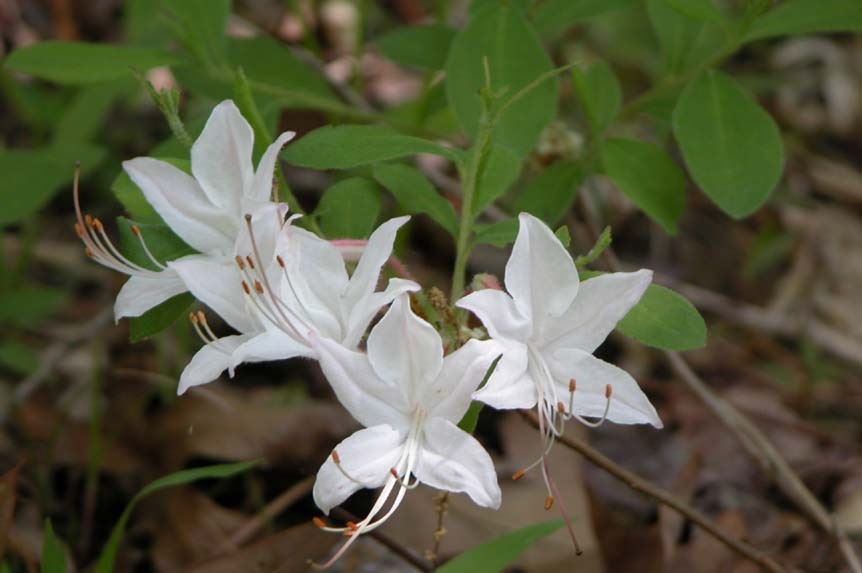
Rose Hips
